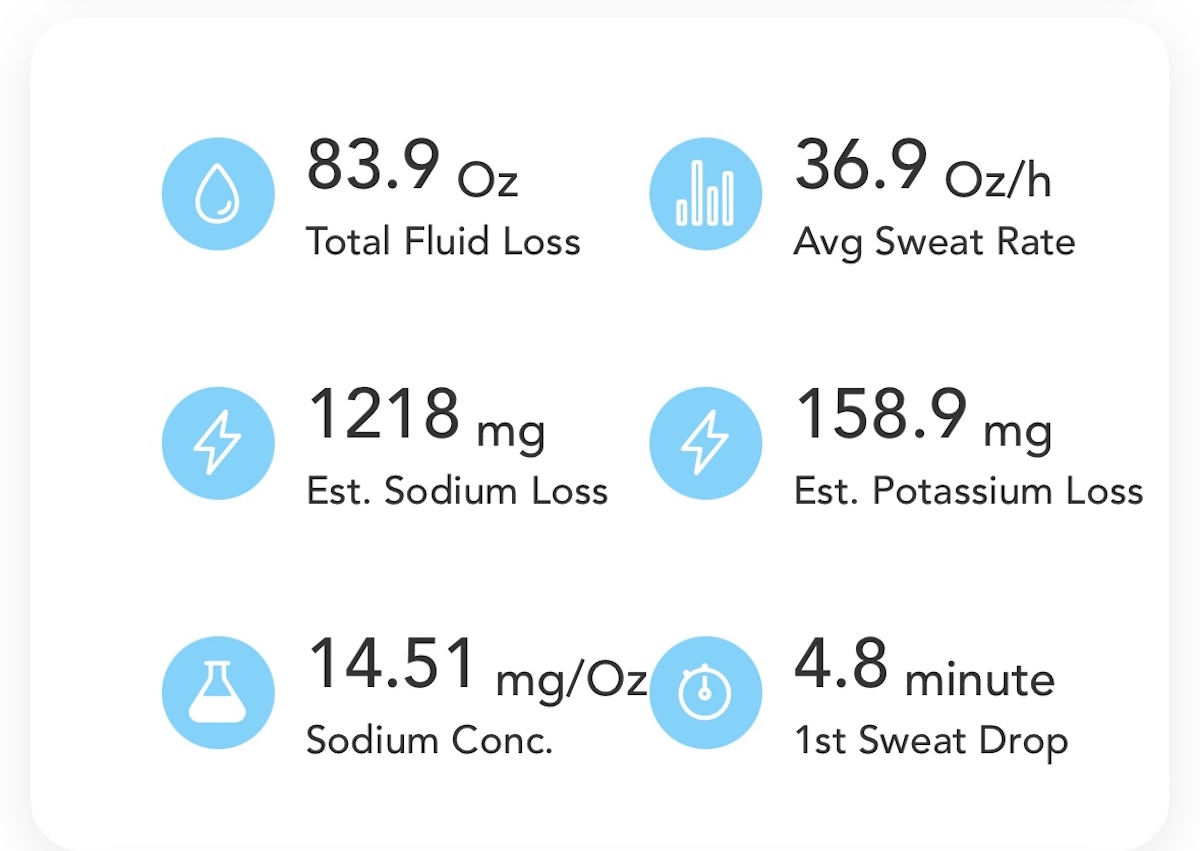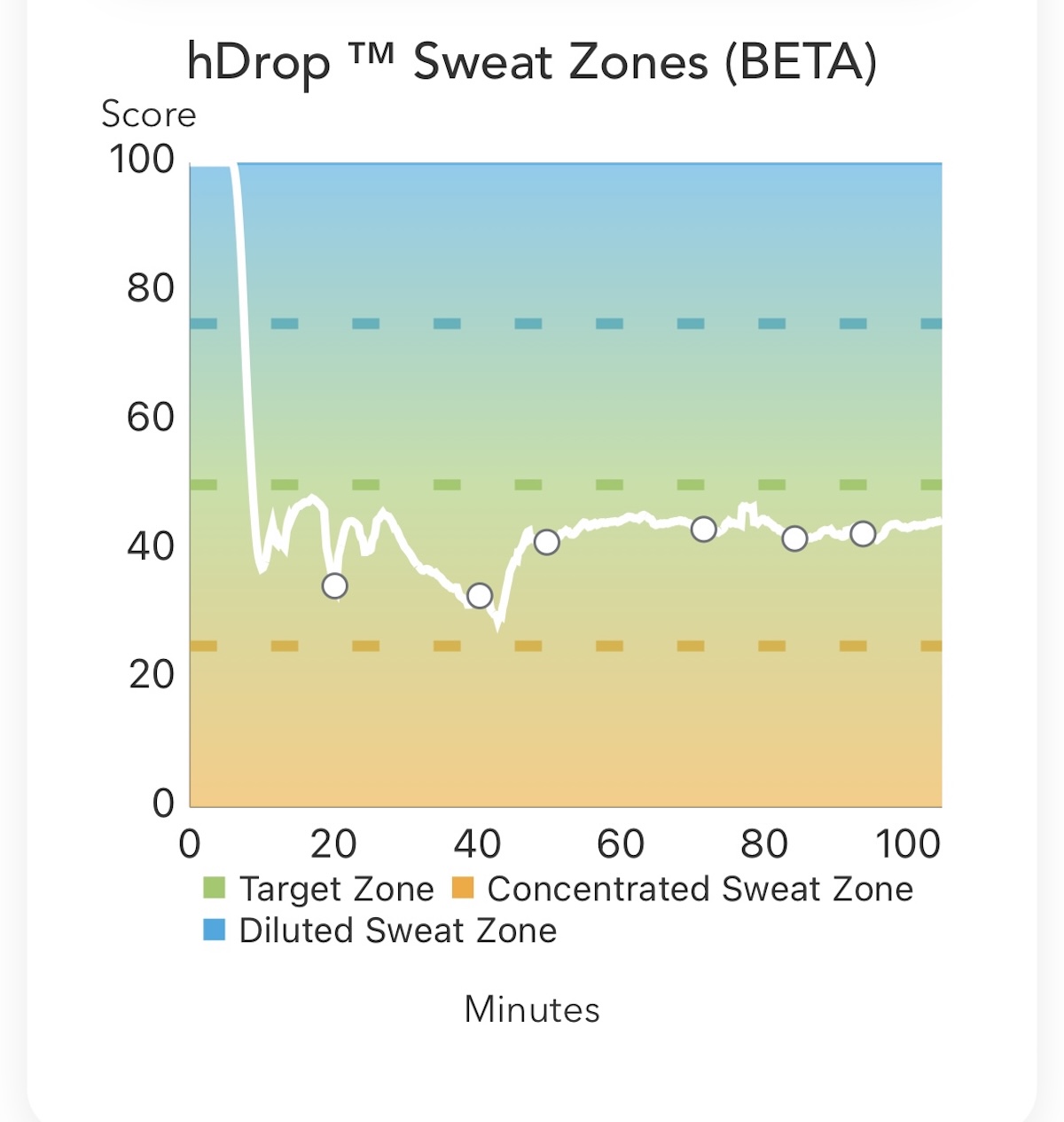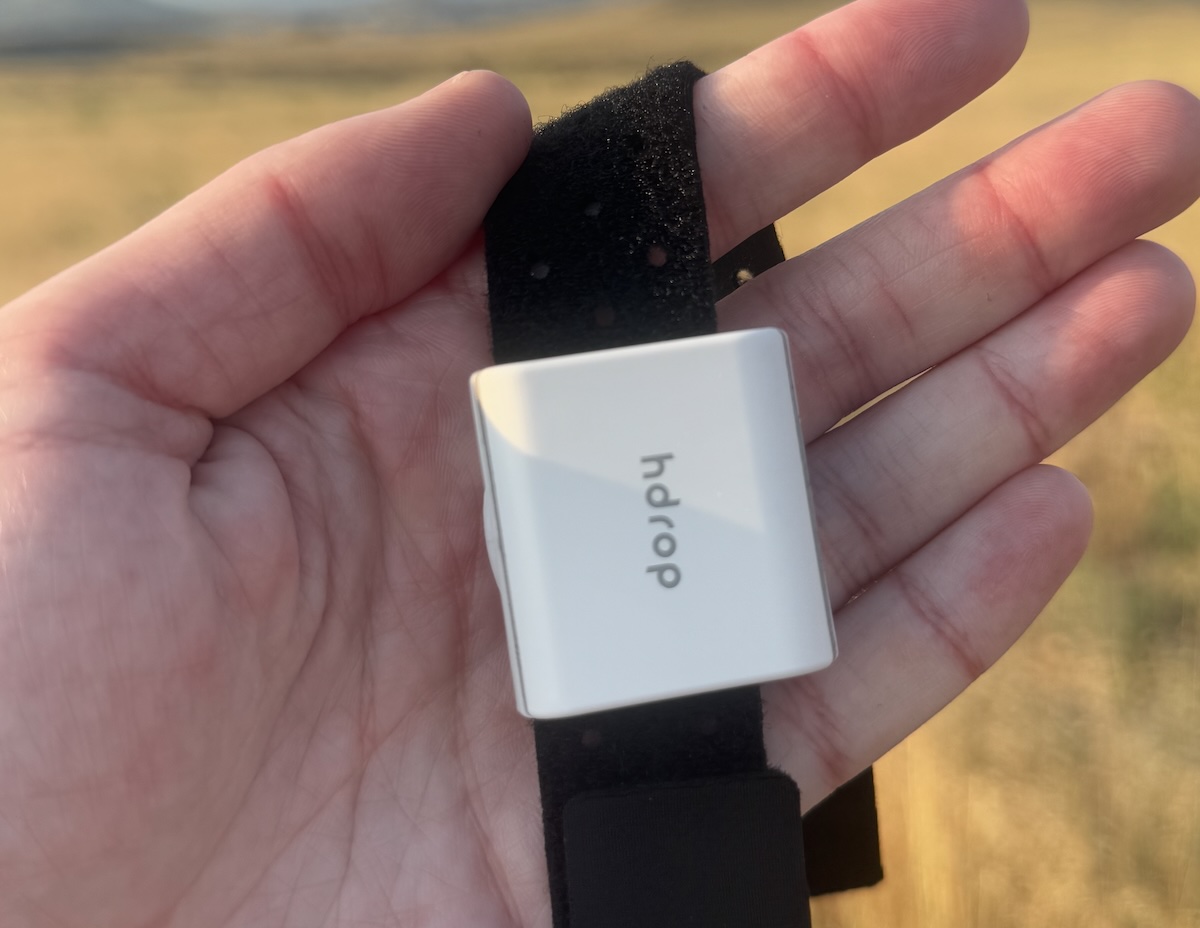As a sports dietitian and self-proclaimed sweat science nerd, I was stoked to get my hands on the hDrop. There are a few different wearable sweat monitors out there but hDrop is the only one that you can use over and over without swapping out sensors – which means that you can wear it every day without any extra cost or hassle.
 Let me back up. What the heck is a sweat monitor and why would we want one? Hydration needs are highly individual and based primarily around two metrics:
Let me back up. What the heck is a sweat monitor and why would we want one? Hydration needs are highly individual and based primarily around two metrics:
- Sweat rate: How much you sweat per hour (in liters or ounces).
- Sodium concentration: How much sodium is in a liter or ounce of sweat.
Both of these metrics are largely genetically determined, but also impacted by things like weather, exercise intensity, and heat acclimation. Both can change from run to run, which means it’s important to measure your sweat while you are actually running.
Runners with a higher sweat rate need to drink more fluids to replace sweat losses… and those with a higher sodium concentration may need to replace more sodium (i.e. electrolytes with higher sodium concentration).
By monitoring your sweat and understanding your sweat rate and sodium concentration, you can better dial in a hydration strategy with less guesswork.
How hDrop Works
After you set up your account, you strap the hDrop onto your upper arm. Hit “start activity” in the mobile app when you are ready to start tracking. When you’re finished with your run, hit “stop activity” and wait a few moments for the data to upload.
Now, you’re ready to look at your data! The app provides an overview of your sweat losses:
 On this run, I lost 83.9 ounces of fluid, or 36.9 ounces per hour. I lost a total of 1218 mg of sodium and 159 mg of potassium. My sodium concentration is 14.51 mg per ounce of fluid. Since I lost 36.9 ounces of fluid per hour, I lost 535 mg of sodium per hour (14.51 x 36.9).
On this run, I lost 83.9 ounces of fluid, or 36.9 ounces per hour. I lost a total of 1218 mg of sodium and 159 mg of potassium. My sodium concentration is 14.51 mg per ounce of fluid. Since I lost 36.9 ounces of fluid per hour, I lost 535 mg of sodium per hour (14.51 x 36.9).
Once you have this data for a few runs, you can start incorporating it into your hydration strategy. hDrop even gives you recommendations for hydration products that match your sweat rate!
hDrop Gen 2Specifications
- 30mm x 30mm x 15mm
- Reusable electrode sensor
- Temperature monitor
- Clip on your clothes, or use band
- Connects with Android, iOS, Garmin and Hammerhead
- Buy at hdroptech.com for $249.99
Quick Take
- Reusuable without having to switch sensors
- Integration with external devices
- Super easy to set up
- Uncomfortable armband
- Accuracy has not been fully determined
Other hDrop Features
In addition to basic sweat testing, the hDrop has a few other features that make it stand out compared with other similar devices:
Integration with external devices:
By integrating your hDrop with your Garmin watch, for example, you can start and stop activities and view live sweat data on the run, right from your watch.
Recovery plan:
After completing an activity, hDrop contextualizes your sodium losses. For example, after my first use, it told me the amount of sodium I lost was similar to the amount found in a tablespoon of soy sauce – not particularly actionable (unless I wanted to go out for Chinese food) but very interesting. It also provides a recommended recovery plan so you can feel confident in rehydrating post-run.
Sweat zones:
While still in beta testing, the zones model is meant to help you guide your hydration to avoid your sweat becoming too concentrated or diluted. In theory, by staying in the optimal zone, you maximize hydration. If your sweat is too concentrated, this may suggest you need to drink more plain water; if it is too dilute, you may need more sodium.
While an interesting feature, results did not seem accurate for me when compared with body cues and past experience.
Provided recommendations are also meant to serve only as a starting point; dilute sweat may not mean you need to drink more electrolytes – it may mean you’ve drank too many fluids altogether. Because zones are still in beta testing, we may see improvements in this feature in the future.
Overall Thoughts
The hDrop is awesome!
It’s super easy to set up and use (even for someone like me who struggles with technology). And for slightly more than the cost of most lab-based sweat tests, you can have personalized sweat data on all of your runs in the palm of your hand.
And, thanks to the latest software update, you no longer need strong cell service or WiFi in order to finish an activity on the app and collect accurate data. This means that you can test your sweat on the most remote of mountain runs.
I do have two primary qualms with the hDrop.
First, the armband is not the most comfortable. The band itself is hard to size, especially if you have even mildly prominent biceps muscles, and the velcro rubs on your skin if you don’t get it perfectly right. S
econd, accuracy has not been fully determined. hDrop reports preliminary findings from an independent research study on their website, showing 92.5% accuracy in sweat rate and 87% accuracy in sodium losses. But anecdotally, my data had a lot of variation that couldn’t be explained by basic hydration and lifestyle factors.
All this to say: data collected from the hDrop is undeniably interesting (or maybe that’s only true if you’re a sweat geek like me!) and can be useful in providing a starting point for creating a hydration strategy for your next long run or race.
But data should be taken with a grain of salt (get it?).
 More importantly, does everyone need this level of precision to monitor their sweat? Probably not!
More importantly, does everyone need this level of precision to monitor their sweat? Probably not!
Most research up to this point has focused on accurately measuring sodium concentration. The reality is, science hasn’t quite figured out what to actually do with this data.
From experience, I’ve found that most runners should replace about 50-75% of sodium losses during their runs. That’s a big range, and one that can be determined through trial and error, without fancy gadgets. That said, consider sweat testing using an hDrop if you:
- Are a uniquely heavy or salty sweater
- Frequently run in hot climates (such as the desert Southwest during the summer)
- Have struggled to find a hydration strategy that works for you
With so much conflicting information out there about hydration, sweat testing offers a clear way to better understand your unique needs. Unlike other tests out there, hDrop can be used while you’re actually running and can be repeated over and over to collect more data – as the seasons change or as you tweak your hydration strategy. Sweat testing isn’t necessary for everyone, but if you are curious about the numbers, hDrop is a great option!
If you’re still scratching your head wondering what all of these numbers mean, a sports dietitian can help interpret your data and develop a custom hydration strategy for your next long run or race.



 5 Best Skechers Walking Shoes for All Day
5 Best Skechers Walking Shoes for All Day